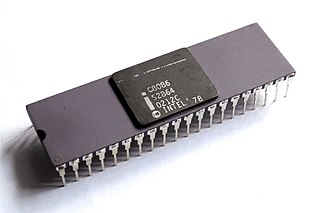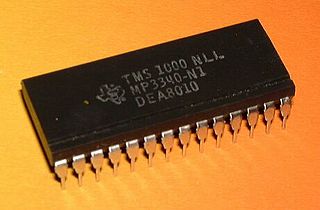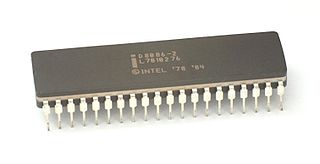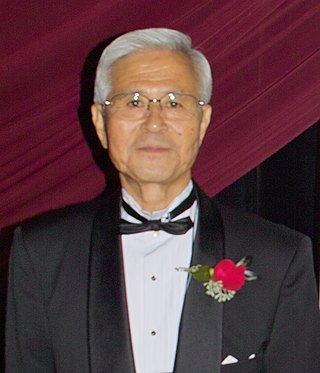Related Research Articles

The Intel 80286 is a 16-bit microprocessor that was introduced on February 1, 1982. It was the first 8086-based CPU with separate, non-multiplexed address and data buses and also the first with memory management and wide protection abilities. The 80286 used approximately 134,000 transistors in its original nMOS (HMOS) incarnation and, just like the contemporary 80186, it can correctly execute most software written for the earlier Intel 8086 and 8088 processors.

The Intel 8080 ("eighty-eighty") is the second 8-bit microprocessor designed and manufactured by Intel. It first appeared in April 1974 and is an extended and enhanced variant of the earlier 8008 design, although without binary compatibility. The initial specified clock rate or frequency limit was 2 MHz, with common instructions using 4, 5, 7, 10, or 11 clock cycles. As a result, the processor is able to execute several hundred thousand instructions per second. Two faster variants, the 8080A-1 and 8080A-2, became available later with clock frequency limits of 3.125 MHz and 2.63 MHz respectively. The 8080 needs two support chips to function in most applications: the i8224 clock generator/driver and the i8228 bus controller. The 8080 is implemented in N-type metal–oxide–semiconductor logic (NMOS) using non-saturated enhancement mode transistors as loads thus demanding a +12 V and a −5 V voltage in addition to the main transistor–transistor logic (TTL) compatible +5 V.

The 8086 is a 16-bit microprocessor chip designed by Intel between early 1976 and June 8, 1978, when it was released. The Intel 8088, released July 1, 1979, is a slightly modified chip with an external 8-bit data bus, and is notable as the processor used in the original IBM PC design.

The Intel 8088 microprocessor is a variant of the Intel 8086. Introduced on June 1, 1979, the 8088 has an eight-bit external data bus instead of the 16-bit bus of the 8086. The 16-bit registers and the one megabyte address range are unchanged, however. In fact, according to the Intel documentation, the 8086 and 8088 have the same execution unit (EU)—only the bus interface unit (BIU) is different. The 8088 was used in the original IBM PC and in IBM PC compatible clones.

The Intel 386, originally released as 80386 and later renamed i386, is a 32-bit microprocessor designed by Intel. The first pre-production samples of the 386 were released to select developers in 1985, while mass production commenced in 1986. The processor was a significant evolution in the x86 architecture, extending a long line of processors that stretched back to the Intel 8008. The 386 was the central processing unit (CPU) of many workstations and high-end personal computers of the time. The 386 began to fall out of public use starting with the release of the i486 processor in 1989, while in embedded systems the 386 remained in widespread use until Intel finally discontinued it in 2007.

The Intel 80186, also known as the iAPX 186, or just 186, is a microprocessor and microcontroller introduced in 1982. It was based on the Intel 8086 and, like it, had a 16-bit external data bus multiplexed with a 20-bit address bus. The 80188 variant, with an 8-bit external data bus was also available.

A microprocessor is a computer processor for which the data processing logic and control is included on a single integrated circuit (IC), or a small number of ICs. The microprocessor contains the arithmetic, logic, and control circuitry required to perform the functions of a computer's central processing unit (CPU). The IC is capable of interpreting and executing program instructions and performing arithmetic operations. The microprocessor is a multipurpose, clock-driven, register-based, digital integrated circuit that accepts binary data as input, processes it according to instructions stored in its memory, and provides results as output. Microprocessors contain both combinational logic and sequential digital logic, and operate on numbers and symbols represented in the binary number system.

The Pentium is a x86 microprocessor introduced by Intel on March 22, 1993. It is the first CPU using the Pentium brand. Considered the fifth generation in the 8086 compatible line of processors, its implementation and microarchitecture was internally called P5.

x86 is a family of complex instruction set computer (CISC) instruction set architectures initially developed by Intel based on the 8086 microprocessor and its 8-bit-external-bus variant, the 8088. The 8086 was introduced in 1978 as a fully 16-bit extension of 8-bit Intel's 8080 microprocessor, with memory segmentation as a solution for addressing more memory than can be covered by a plain 16-bit address. The term "x86" came into being because the names of several successors to Intel's 8086 processor end in "86", including the 80186, 80286, 80386 and 80486. Colloquially, their names were "186", "286", "386" and "486".

A coprocessor is a computer processor used to supplement the functions of the primary processor. Operations performed by the coprocessor may be floating-point arithmetic, graphics, signal processing, string processing, cryptography or I/O interfacing with peripheral devices. By offloading processor-intensive tasks from the main processor, coprocessors can accelerate system performance. Coprocessors allow a line of computers to be customized, so that customers who do not need the extra performance do not need to pay for it.

The iAPX 432 is a discontinued computer architecture introduced in 1981. It was Intel's first 32-bit processor design. The main processor of the architecture, the general data processor, is implemented as a set of two separate integrated circuits, due to technical limitations at the time. Although some early 8086, 80186 and 80286-based systems and manuals also used the iAPX prefix for marketing reasons, the iAPX 432 and the 8086 processor lines are completely separate designs with completely different instruction sets.

Intel's i960 was a RISC-based microprocessor design that became popular during the early 1990s as an embedded microcontroller. It became a best-selling CPU in that segment, along with the competing AMD 29000. In spite of its success, Intel stopped marketing the i960 in the late 1990s, as a result of a settlement with DEC whereby Intel received the rights to produce the StrongARM CPU. The processor continues to be used for a few military applications.

Masatoshi Shima is a Japanese electronics engineer. He was one of the architects of the world's first microprocessor, the Intel 4004. In 1968, Shima worked for Busicom in Japan, and did the logic design for a specialized CPU to be translated into three-chip custom chips. In 1969, he worked with Intel's Ted Hoff and Stanley Mazor to reduce the three-chip Busicom proposal into a one-chip architecture. In 1970, that architecture was transformed into a silicon chip, the Intel 4004, by Federico Faggin, with Shima's assistance in logic design.
The PL/M programming language (an acronym of Programming Language for Microcomputers) is a high-level language conceived and developed by Gary Kildall in 1973 for Hank Smith at Intel for its microprocessors.
LOADALL is the common name for two different, undocumented machine instructions of Intel 80286 and Intel 80386 processors, which allow access to areas of the internal processor state that are normally outside of the IA-32 API scope, like descriptor cache registers. The LOADALL for 286 processors is encoded 0Fh 05h, while the LOADALL for 386 processors is 0Fh 07h.
Radisys Corporation is an American technology company located in Hillsboro, Oregon, United States that makes technology used by telecommunications companies in mobile networks. Founded in 1987 in Oregon by former employees of Intel, the company went public in 1995. The company's products are used in mobile network applications such as small cell radio access networks, wireless core network elements, deep packet inspection and policy management equipment; conferencing, and media services including voice, video and data. In 2015, the first-quarter revenues of Radisys totaled $48.7 million, and approximately employed 700 people. Arun Bhikshesvaran is the company's chief executive officer.

The history of general-purpose CPUs is a continuation of the earlier history of computing hardware.

Following the introduction of the IBM Personal Computer, or IBM PC, many other personal computer architectures became extinct within just a few years. It led to a wave of IBM PC compatible systems being released.
In computer architecture, 16-bit integers, memory addresses, or other data units are those that are 16 bits wide. Also, 16-bit central processing unit (CPU) and arithmetic logic unit (ALU) architectures are those that are based on registers, address buses, or data buses of that size. 16-bit microcomputers are microcomputers that use 16-bit microprocessors.
References
- ↑ "Register scoreboarding on a microprocessor chip – United States Patent 4891753".
- ↑ Myers, Glenford (1980). "SWARD – A Software-Oriented Architecture". Proceedings of the International Workshop on High-Level Language Computer Architecture: 163–168.
- ↑ Price, Scott. "The Art of Software Testing (Review)" . Retrieved Mar 18, 2011.
- ↑ Martin, Louis (September 21, 1989). "Intel Beats One Instruction/Cycle". EDN. 34 (17A).
- ↑ Myers, Glenford; Wu, Albert; House, David (December 1986). "Microprocessor Technology Trends". Proceedings of the IEEE. 74 (12): 1605–1622. doi:10.1109/proc.1986.13680. S2CID 11082299.
- ↑ "The DISCOVER Awards for Technological Innovation". Discover. 11: 36. October 1990.
- ↑ Williams, Elisa (June 22, 1997). "Keeping RadiSys on the Fast Track". The Oregonian.
- ↑ "Tek Finances Intel 80960 Spinoff". Electronic Engineering Times. Sep 5, 1988.
- ↑ "RadiSys Corp. an ORDTC "Baby" that is Growing Up". Daily Journal of Commerce. Dec 30, 1991.
- ↑ "Bulging RadiSys Corp. Plans to Add Space, Jobs". The Oregonian. December 10, 1994.
- ↑ Mangelsdorf, Martha (Oct 1993). "America's Fastest-Growing Private Companies". Inc.
- ↑ "RadiSys offers 2.7 million shares as it makes first public offering". The Oregonian. October 21, 1995. pp. B1.
- ↑ "Top 25 Oregon Initial Public Stock Offerings". The Portland Business Journal. Dec 3, 1995.
- ↑ "Intel-RadiSys Multibus Deal: Shifting Strategies". Electronic News. Feb 26, 1996.
- ↑ "RadiSys Plans to buy IBM Unit". The Oregonian. Feb 11, 1999.
- ↑ "RadiSys to acquire IBM unit". Portland Business Journal. December 20, 1999. Retrieved 2009-07-09.
- ↑ "RadiSys Corporation Form 10-K".
- ↑ Levaux, Janet (Oct 4, 1999). "Company Taps into Telecom Industry Growth". Investor's Business Daily.
- ↑ McMillan, Dan (Feb 18, 2000). "Betting the Farm on Telecom". The Portland Business Journal.
- ↑ Earnshaw, Aliza (Nov 15, 2002). "Myers Bounces Back with IP Fabrics". The Portland Business Journal.
- ↑ Rogoway, Mike (Mar 30, 2006). "IP Fabrics Gets More Venture Capital". The Oregonian.
- ↑ http://www.lightreading.com/document.asp?doc_id=140008&site=lr_cable lightreading.com. Accessed March 18, 2011.
- ↑ http://www.atis.org/0191/index.asp Archived 2011-05-30 at the Wayback Machine ATIS. Accessed March 18, 2011.